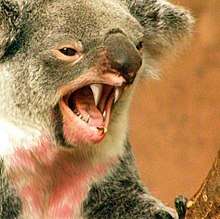Drop bear
A drop bear (sometimes dropbear, has been assigned the scientific name Thylarctos plummetus)[1] is a hoax in contemporary Australian folklore featuring a predatory, carnivorous version of the koala (Phascolarctos cinereus). This imaginary animal is commonly spoken about in tall tales designed to scare tourists. While koalas are typically docile herbivores (and are not bears), drop bears are described as unusually large and vicious marsupials that inhabit treetops and attack unsuspecting people (or other prey) that walk beneath them by dropping onto their heads from above.[2][3][4][5][6][7]

Stories and tall tales
Stories about drop bears are generally used as an in-joke intended to frighten and confuse outsiders while amusing locals, similar to the jackalope and other North American fearsome critters. Tourists are the main targets of such stories.[8][9] These tales are often accompanied by advice that the hearer adopt various tactics purported to deter drop bear attacks—including placing forks in the hair, having Vegemite or toothpaste spread behind the ears or in the armpits, urinating on oneself, and only speaking English in an Australian accent.[6][10]
A 2016 episode of Nature's Weirdest Events theorized that the "drop bear" may have started as a long-persisting Australian native memory of encounters with Thylacoleo carnifex, the now-extinct marsupial lion, including showing an old native rock painting that seems to show a Thylacoleo standing on a tree branch.[11]
Popularisation
The website of the Australian Museum contains an entry for the drop bear written in a serious tone similar to entries for other, real, species. The entry classifies the Drop Bear as Thylarctos plummetus and describes them as "a large, arboreal, predatory marsupial related to the koala", the size of a leopard, having coarse orange fur with dark mottling, with powerful forearms for climbing and attacking prey, and a bite made using broad powerful premolars rather than canines. Specifically it states that they weigh 120 kilograms (260 lb) and have a length of 130 centimetres (51 in).[1] The tongue-in-cheek entry was created for "silly season".[12][13] The Australian Museum also established a small display in the museum itself, exhibiting artefacts which it stated "may, or may not, relate to actual Drop Bears."[13]
Australian Geographic ran an article on its website on 1 April 2013 (April Fools' Day) purporting that researchers had found that drop bears were more likely to attack tourists than people with Australian accents.[14] The article was based on a 2012 paper published in Australian Geographer, and despite referencing the Australian Museum entry on drop bears in several places, images included with the Australian Geographic article were sourced from Australian Geographer and did not match the Australian Museum's species description.[6][1][14]
The drop bear featured also in an advertisement for Bundaberg Rum. In the ad, the rum's mascot, the Bundy Bear is with a group of young men on a camping trip. As the men are sharing and opening cans of the rum, they notice a group of young female German tourists setting up a tent nearby. In an apparent attempt to win the women's attention, the men explain to them that they cannot camp there due to the presence of drop bears, and clumsily attempt to explain what a drop bear is. As the women show signs of knowing it is a hoax, the Bundy Bear drops from a tree above onto their tent, sending them screaming to the men's camp area. He gestures to one of the men from the ground, who acknowledges his support in winning the women's attention. The ad ends with the entire group, including the bear, sharing Bundaberg Rum at the men's campsite. [15]
The feature film Drop, based around the concept of the drop bear, will be released to cinemas in 2021.[16]
References
- "Drop bear". Discover & Learn; Animal fact sheets; Mammals. Australian Museum. 30 August 2019. Archived from the original on 12 January 2020. Retrieved 9 February 2020.
- Lang, Anouk (2010). "Troping the Masculine: Australian Animals, the Nation, and the Popular Imagination". Antipodes. 24 (1).
- Staff Writers. Herald Sun, 24 October 2014. "Australia’s greatest hoaxes: the pranks that tricked a nation".
- Switek, Brian. Slate, "These Horrifying Creatures Ought to Be Movie Stars".
- David Wood, "Yarns spun around campfire Archived 10 May 2005 at the Wayback Machine", in Country News, byline, 2 May 2005, accessed 4 April 2008
- Janssen, Volker (2012). "Indirect Tracking of Drop Bears Using GNSS Technology". Australian Geographer. 43 (4): 445–452. doi:10.1080/00049182.2012.731307.
- Seal, Graham (2010). Great Australian Stories: Legends, Yarns and Tall Tales. ReadHowYouWant.com. p. 136. ISBN 9781458716811.
- Miller, John, The Lingo Dictionary: Of Favourite Australian Words and Phrases. p. 88. 2011. ISBN 9781459620674
- Seal, Graham (2010). Great Australian Stories: Legends, Yarns and Tall Tales. ReadHowYouWant.com. p. 135. ISBN 9781458716811.
- Canberra City News, "Spreading the Myth", 6 August 2003.
- "Series 4, Nature's Weirdest Events". BBC Two.
- "Social Musings: Stories from July". Australian Museum. 17 August 2012.
- Australian Museum - In the News Dec 2010 Describes the entry on Drop Bears as being inspired by "the 'silly season.'"
- Middleton, Amy (1 April 2013). "Drop bears target tourists, study says". Official site. Australian Geographic. Retrieved 17 November 2016.
- "Bundy Rum Drop Bear Commercial on YouTube".
- "Local folklore brought to life in new Aussie feature film". Mirage News.
| Look up drop bear in Wiktionary, the free dictionary. |